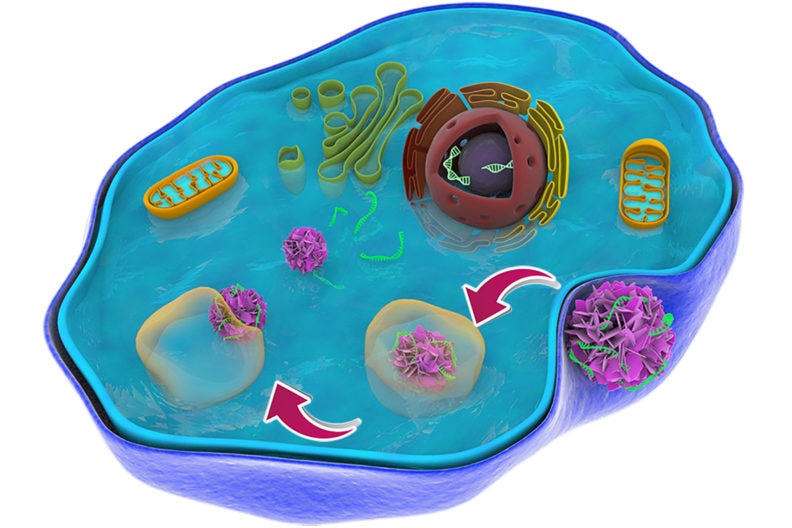Jan 11 2019
Scientists at Washington State University have devised a new method for supplying drugs and therapies into cells at the nanoscale without resulting in harmful effects that have hindered other such efforts.
 Schematic representation of the movement of the flower-like particle as it makes its way through a cellular trap to deliver therapeutic genes. (Image credit: Washington State University)
Schematic representation of the movement of the flower-like particle as it makes its way through a cellular trap to deliver therapeutic genes. (Image credit: Washington State University)
In the near future, the work could result in more effective diagnostics and therapies for cancer and other diseases.
The research group led by Yuehe Lin, professor in WSU’s School of Mechanical and Materials Engineering, and Chunlong Chen, senior scientist at the Department of Energy’s Pacific Northwest National Laboratory (PNNL), produced biologically inspired materials at the nanoscale with the ability to efficiently carry model therapeutic genes into tumor cells. The outcomes of the study have been published in the journal Small.
Scientists have been striving to create nanomaterials that have the ability to effectively deliver therapeutic genes directly into the cells for treating diseases such as cancer. Low medicine delivery efficiency and potential toxicity are the major problems faced in gene delivery using nanomaterials.
To develop nanotechnology for medical purposes, the first thing to consider is toxicity — That is the first concern for doctors.
Yuehe Lin, Professor, School of Mechanical and Materials Engineering, Washington State University.
The size of the flower-like particle developed by the WSU and PNNL team is around 150 nm, or almost one thousand times smaller compared to the thickness of a piece of paper. It is composed of sheets of peptoids, which are analogous to natural peptides that constitute proteins. The peptoids can be used as a good drug delivery particle since they are quite easy to produce, are analogous to natural biological materials, and work well in biological systems.
In order to trace the peptoid nanoflowers as they move through cells, the researchers added fluorescent probes to them. Also, they added the element fluorine, which helped the nanoflowers to escape more easily from complicated cellular traps that usually hinder drug delivery.
Upon loading the flower-like particles with therapeutic genes, they could easily make their way out of the expected cellular trap, enter the core of the cell, and deliver their drug there.
“The nanoflowers successfully and rapidly escaped (the cell trap) and exhibited minimal cytotoxicity,” stated Lin.
As soon as their initial testing with model drug molecules is completed, the researchers expect to carry out further analyses using real medicines.
This paves a new way for us to develop nanocargoes that can efficiently deliver drug molecules into the cell and offers new opportunities for targeted gene therapies.
Yuehe Lin, Professor, School of Mechanical and Materials Engineering, Washington State University.
A patent application has been filed by the WSU and PNNL team for the new technology, and the researchers are looking for industrial partners for further development.
The research was funded by Washington State University start-up funds and the Department of Energy.